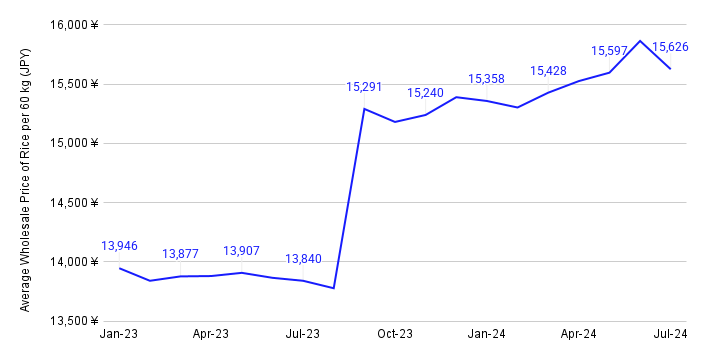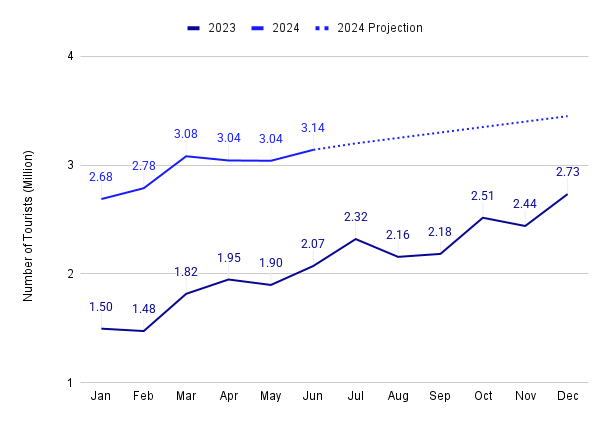Nationwide Rice Shortage in Japan, Worsen by Earthquake Warnings

Poor Harvest from Unfavorable Weather Conditions
According to the Japan Meteorological Agency (JMA), Japan had the hottest summer in 2023, from June through August, 1.76°C above the average temperature. The main reasons for the poor harvest are the unrelenting heatwaves and low rainfall in key rice-producing areas such as the Niigata Prefecture. The Ministry of Agriculture, Forestry, and Fisheries (MAFF) reports the average wholesale price in Aug-23 was USD 105.25 (JPY 15,291) per 60 kilograms (kg), up USD 94.77 (JPY 13,777) from last year, marking a 10.99% YoY increase.
Average Wholesale Price of Rice per 60 kg (Jan-23 to Jul-24)

Source: The Ministry of Agriculture, Forestry, and Fisheries
The MAFF further announced that expected harvest volume for rice in the marketing year 2023-2024 to be 6.61 million metric tons (mmt), which is 91,000 metric tons (mt) lower than last season’s harvest.
Surge in Tourist Demand Exacerbates Shortages
Despite the poor harvest, Japan’s steady decline in domestic rice consumption due to the shrinking population and changing diets meant that the lower-than-expected yield was not a significant concern. However, the influx of tourists in the past year has offset this trend.
Japan has seen a sharp increase in tourists in the past year after lifting COVID-19 restrictions and the weakening yen. According to the Japan National Tourism Organization (JNTO), Japan was greeted with an estimated 3.16 million tourists in Jun-24, a 51.2% increase year-on-year (YoY). This has increased rice consumption as tourists seek out Japanese dishes such as sushi, onigiri, and donburi. Thus, domestic demand for rice increased to 7.02 mmt for the first time in 10 years during the same period.
Monthly Tourist Arrivals in Japan (2023–2024)

Source: Japan National Tourism Organization (JNTO)
By the end of Jun-24, Japan’s rice inventories from the private sector fell to 1.56 mmt, a 20.8% decrease YoY and the lowest since the beginning of data collection in 1999. This number is also significantly below 1.8 to 2 mmt, which is considered necessary to balance supply and demand for rice in Japan.
Rice Shortages Worsen with Megaquake Advisory
The shortage sparked price hikes in several key rice brands. According to MAFF, the average wholesale price in Jun-24 was USD 109.16 (JPY 15,865) per 60 kilograms (kg), up USD 13.76 (JPY 2,000) from last year, marking a 14.4% YoY increase. Major retail stores such as Life and Seiyu also report rice shortages on their shelves and have even put up one bag per consumer purchase limit.
However, this sentiment is further doubted as Japan issued a week-long megaquake advisory for the first time. This was issued after the JMA announced a higher-than-normal chance of a megaquake striking Japan after a 7.1-magnitude earthquake hit the Nankai Trough in early Aug-24. Meteorologists estimate the once-in-a-century megaquake, which is expected to hit in the next 30 years, with a magnitude of 8 to 9 and could potentially take 200,000 lives and displace thousands more. This sparked panic buying, where people stock up on essential items such as toilet paper, bottled water, and rice. This has led to the worsening rice shortages in the country.
Government Response and Future Outlook
Despite public concern, the Japanese government is adamant that the shortage is temporary and will return to stable conditions when this year’s harvest becomes available in Sep-24. No announcements have been made about whether the government plans to tap into the 1 mmt government rice reserve, which is stockpiled yearly in case of bad harvests and natural disasters.
In addition, officials in the Niigata prefecture announced that they are investing more in heat-resilient crop varieties in light of last year’s poor harvest. The Niigata government announced that a heat-resilient variety called Shinnosuke was planted on more than 5,300 hectares (ha), 20% more than in 2023. Although this is a significant increase, only a small percentage of rice crops planted in Japan are heat-resilient varieties. Thus, the Japanese government will have to invest in more climate-resilient varieties and planting techniques as climate change wreaks havoc and brings on more extreme weather.